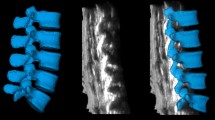Abstract
Background and objectives
The present study was designed to compare the feasibility of ultrasound (US)-guided lumbar epidural access using paramedian sagittal scanning (PMSS) and paramedian transverse scanning (PMTS) approaches.
Methods
Fifty patients undergoing surgery of the lower extremities were randomly allocated into 2 groups. The patients in PMSS group received PMSS-guided in-plane epidural access, whereas patients in PMTS group received PMTS-guided in-plane epidural access. The US visibility of neuraxial structures and of Tuohy needle during US scout scan, procedure duration, the number of attempts to access epidural space, Tuohy needle puncture depth in the epidural space, and extent of sensory block after spinal block between two groups were compared.
Results
The US visibility of Tuohy needle and neuraxial structures was comparable between two groups. There was an overall decrease in procedure duration in the PMTS group relative to the PMSS group (360 ± 42 vs. 490 ± 38 s). The number of attempts needed to access the epidural space in PMSS group was significantly higher than in PMTS group. Distances between the epidural space and the puncture site in PMSS group and PMTS group showed a significant difference (7.13 ± 0.67 vs. 5.24 ± 0.21 cm). No significant differences in the extent of sensory block after spinal block were observed.
Conclusions
We found that PMTS approach was superior as a means of achieving epidural access relative to the PMSS approach, since PMTS approach can be conducted more quickly given shorter path of the needle and less times needed for epidural access during this procedure.
Clinical trial registration
Chinese Clinical Trial Registry, clinical trial number ChiCTR1800015815, date of registration April 24, 2018.


Similar content being viewed by others
References
Chauhan AK, Bhatia R, Agrawal S. Lumbar epidural depth using transverse ultrasound scan and its correlation with loss of resistance technique: a prospective observational study in Indian population. Saudi J Anaesth. 2018;12:279–82.
Arzola C, Mikhael R, Margarido C. Spinal ultrasound versus palpation for epidural catheter insertion in labour: a randomised controlled trial. Eur J Anaesth. 2015;32:499–505.
Ecimovic P, Loughrey JPR. Ultrasound in obstetric anaesthesia: a review of current applications. Int J Obstet Anesth. 2010;19:320–6.
Broadbent CR, Maxwell WB, Ferrie R. Ability of anaesthetists to identify a marked lumbar interspace. Anaesthesia. 2015;55:1122–6.
Grau T, Leipold RW, Fatehi S. Real-time ultrasonic observation of combined spinal-epidural anaesthesia. Eur J Anaesthesiol. 2004;21:25–31.
Shaikh F, Brzezinski J, Alexander S. Ultrasound imaging for lumbar punctures and epidural catheterisations: systematic review and meta-analysis. BMJ. 2013;346:f1720.
Lim YC, Choo CY, Tan KTJ. A randomised controlled trial of ultrasound-assisted spinal anaesthesia. Anaesth Intensive Care. 2014;42:191–8.
Grau T, Leipold RW, Conradi R. Efficacy of ultrasound imaging in obstetric epidural anesthesia. J Clin Anesth. 2002;14:169–75.
Chin A, Crooke B, Heywood L. A randomised controlled trial comparing needle movements during combined spinal-epidural anaesthesia with and without ultrasound assistance. Anaesthesia. 2018;73:466–73.
Srinivasan KK, Leo AM, Iohom G. Pre-procedure ultrasound-guided paramedian spinal anaesthesia at L5–S1: is this better than landmark-guided midline approach? A randomised controlled trial. Indian J Anaesth. 2018;62:53–60.
Conroy PH, Luyet C, Mccartney CJ. Real-time ultrasound-guided spinal anaesthesia: a prospective observational study of a new approach. Anesthesiol Res Pract. 2012;2013:525818.
Vallejo MC, Phelps AL, Singh S. Ultrasound decreases the failed labor epidural rate in resident trainees. Int J Obstet Anesth. 2010;19:373–8.
Carvalho JC. Ultrasound-facilitated epidurals and spinals in obstetrics. Anesthesiol Clin. 2008;26:145–58.
Karmakar MK, Li X, Ho AM. Real-time ultrasound-guided paramedian epidural access: evaluation of a novel in-plane technique. Br J Anaesth. 2009;102:845–54.
Gnaho A, Nau A, Gentili ME. Real-time ultrasound-guided epidural catheter insertion in obese parturients. Obst Anesth Digest. 2016;36:161.
Wang Y, Wang G, Ma D. Real-time ultrasound-guided paramedian epidural access using a paramedian transverse oblique scan: a prospective case series. J Anesth Perioper Med. 2018;5:70–6.
Chin KJ, Perlas A, Chan V. Ultrasound imaging facilitates spinal anesthesia in adults with difficult surface anatomic landmarks. Anesthesiology. 2011;115:94–101.
Chin KJ, Karmakar MK, Peng P. Ultrasonography of the adult thoracic and lumbar spine for central neuraxial blockade. Anesthesiology. 2011;114:1459–85.
Legrand E, Chappard D, Pascaretti C. Trabecular bone microarchitecture, bone mineral density, and vertebral fractures in male osteoporosis. J Bone Miner Res. 2000;15:13–9.
Saleem S, Aslam HM, Rehmani MA. Lumbar disc degenerative disease: disc degeneration symptoms and magnetic resonance image findings. Asian Spine J. 2013;7:322–34.
Norris MC, Grieco WM, Borkowski M. Complications of labor analgesia: epidural versus combined spinal epidural techniques. Anesth Analg. 1994;79:529–37.
Cook TM. Combined spinal-epidural techniques. Anaesthesia. 2000;55:42–644.
Acknowledgements
This work was supported by Fostering Program for High-level Health and Technical Personnel in Beijing (Discipline Backbone) (No. 2013-3-018) to Dr. Yun Wang.
Author information
Authors and Affiliations
Contributions
HL, YK, LJ, DM, YL, and YW report no disclosures. YW was responsible for study design and performed the procedures. HL and YK contributed equally to this work including protocol design, data acquisition, data analysis, and manuscript drafting. DM and LJ were involved in writing the manuscript. YL and HL were involved in selecting appropriate patients and revising the article critically. All the authors approved the final version of the manuscript.
Corresponding author
Ethics declarations
Conflict of interest
The authors declare no conflicts of interest.
Additional information
Publisher's Note
Springer Nature remains neutral with regard to jurisdictional claims in published maps and institutional affiliations.
Electronic supplementary material
Below is the link to the electronic supplementary material.
Supplementary file1 (AVI 76670 kb)
About this article
Cite this article
Li, H., Kang, Y., Jin, L. et al. Feasibility of ultrasound-guided lumbar epidural access using paramedian transverse scanning with the needle in-plane: a comparison with paramedian sagittal scanning. J Anesth 34, 29–35 (2020). https://doi.org/10.1007/s00540-019-02704-7
Received:
Accepted:
Published:
Issue Date:
DOI: https://doi.org/10.1007/s00540-019-02704-7




